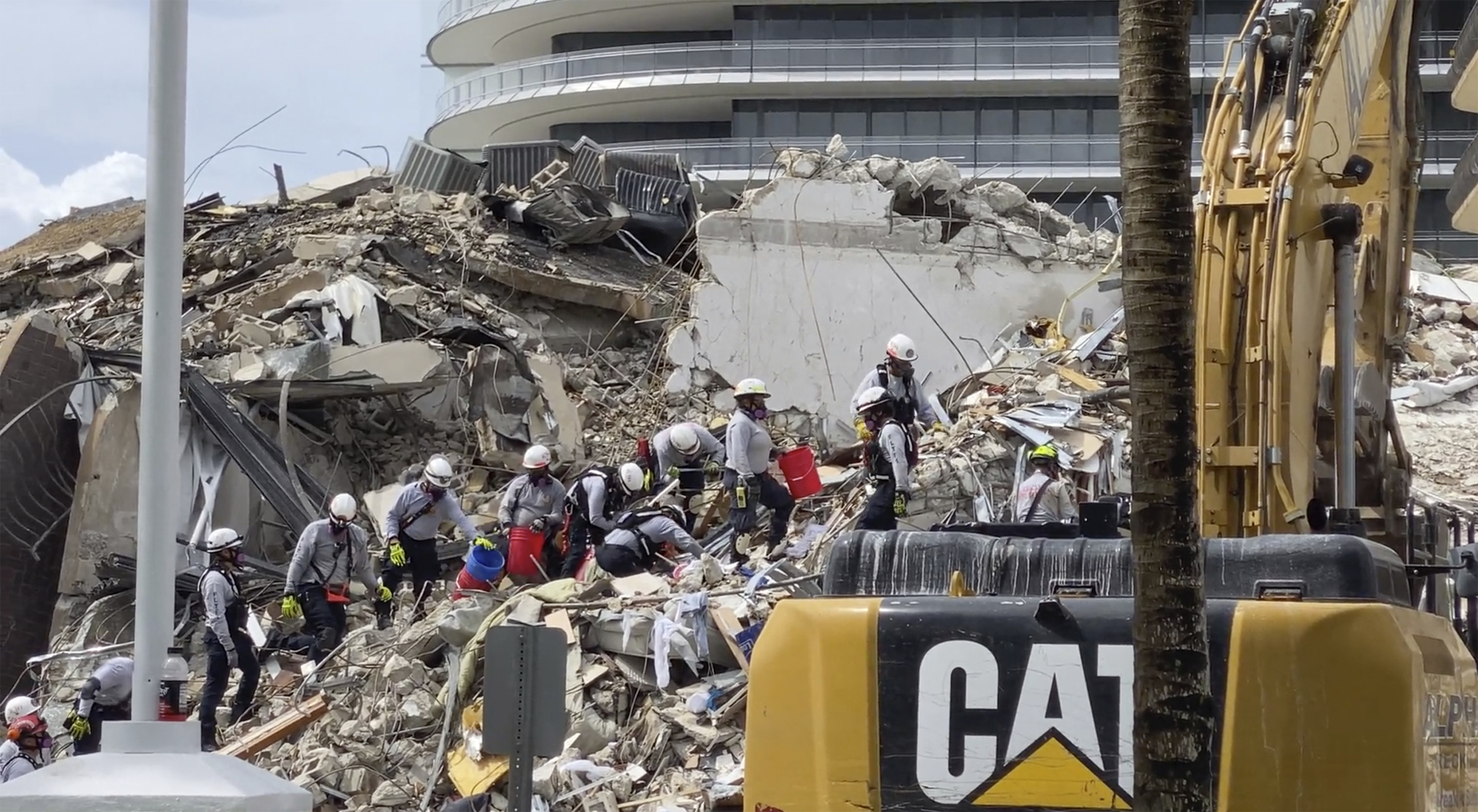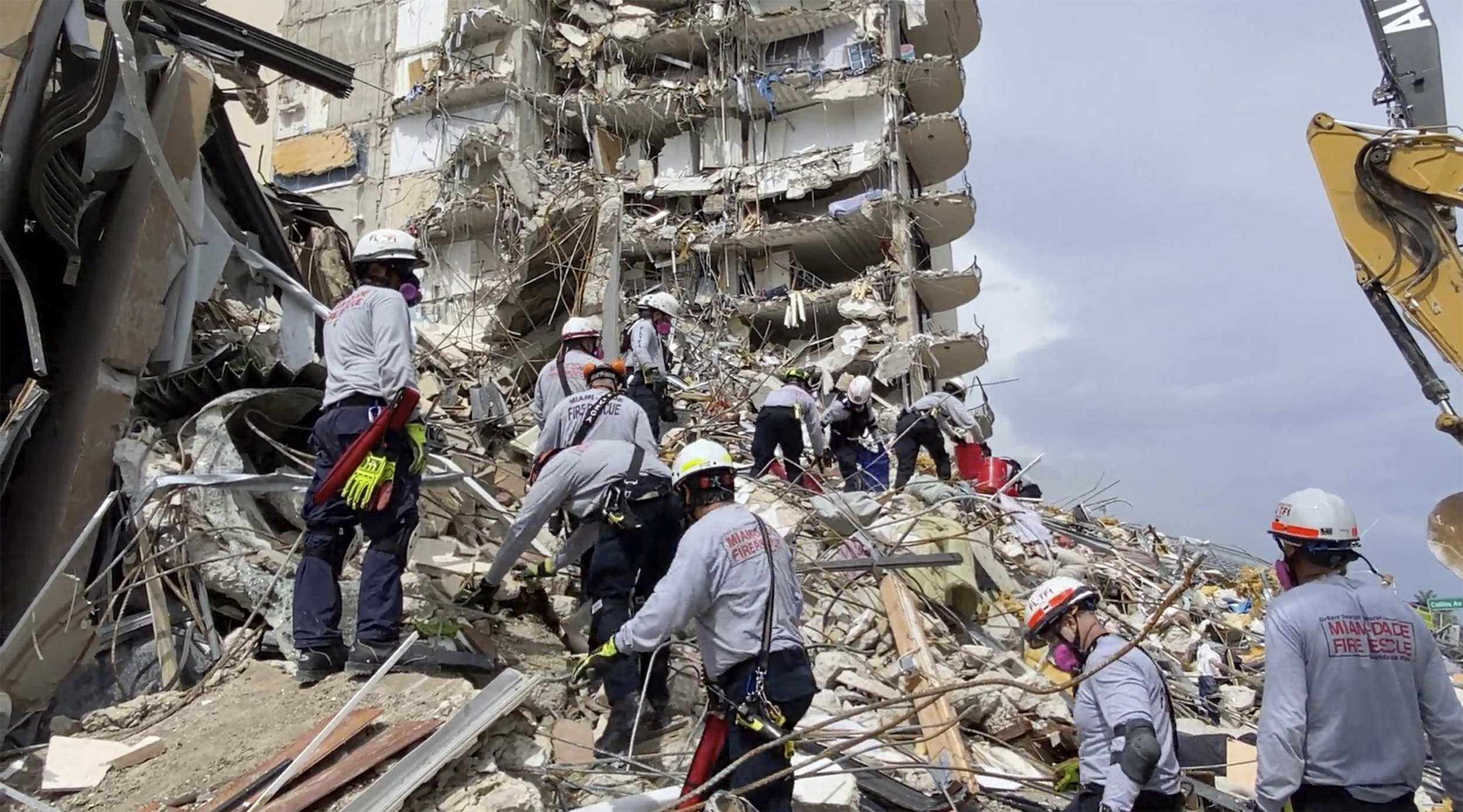Families of the missing visited the scene of the Surfside condo building collapse Sunday as rescuers kept digging through the mound of rubble and clinging to hope that someone could yet be alive somewhere under the broken concrete and twisted metal.
Buses brought several groups of relatives to a place where they could view the pile and the rescuers at work. As relatives returned to a nearby hotel, several paused to embrace as they got off the bus. Others walked slowly with arms around each other back to the hotel entrance.
“We are just waiting for answers. That’s what we want,” said Dianne Ohayon, whose parents, Myriam and Arnie Notkin were in the building. “It’s hard to go through these long days and we haven’t gotten any answers yet.”
The office of Miami-Dade Mayor Daniella Levine Cava said in a statement that the visit on Sunday is a private and "deeply emotional" moment for the families.
At a news briefing Sunday, Cava announced the death toll rose by just four people, to a total of nine confirmed dead. She said "additional human remains" were also recovered from the rubble and that DNA samples from family members are being gathered to help identify them.
The latest four victims were identified Sunday night by police as Christina Beatriz Elvira, 74; Luis Bermudez, 26; Leon Oliwkowicz, 80; and Anna Ortiz, 46.
After almost four full days of search-and-rescue efforts, 152 additional people were still missing in Surfside. No one has been pulled alive from the pile since Thursday, hours after the collapse.
Some families had hoped their visit would allow them to shout messages to loved ones possibly buried deep inside the pile.
Israeli Diaspora Affairs Minister Nachman Shai, who visited with family members, led a humanitarian delegation to Surfside that included several Israeli experts in search-and-rescue operations. He said the experts have told him of cases where survivors were found after 100 hours or more.
Get a weekly recap of the latest San Francisco Bay Area housing news. Sign up for NBC Bay Area’s Housing Deconstructed newsletter.
“So don’t lose hope, that’s what I would say. But you have everyone understanding the longer it takes, the prospects of finding someone alive goes down,” he said.
“If you watch the scene, you know it’s almost impossible to find someone alive,” Shai added. “But you never know. Sometimes miracles happen, you know? We Jews believe in miracles.”
Rescuers sought to reassure families that they were doing as much as possible to find missing loved ones, but the crews said they needed to work carefully for the best chance of uncovering survivors.
Some relatives have been frustrated with the pace of rescue efforts.
“My daughter is 26 years old, in perfect health. She could make it out of there,” one mother told rescuers during a weekend meeting with family members. A video of the meeting was posted on Instagram.
“It’s not enough,” continued the mother, who was among relatives who pushed authorities to bring in experts from other countries to help. “Imagine if your children were in there.”
Scores of rescue workers remained on the massive heap of rubble Sunday, searching for survivors but so far finding only bodies and human remains.
In a meeting with families Saturday evening, people moaned and wept as Miami-Dade Assistant Fire Chief Raide Jadallah explained why he could not answer their repeated questions about how many victims they had found.
“It’s not necessarily that we’re finding victims, OK? We’re finding human remains,” Jadallah said, according to the video posted on Instagram.
He noted the pancake collapse of the 12-story building, which had crumbled into a rubble pile that could be measured in feet. Those conditions have frustrated crews looking for survivors, he said.
Every time crews find remains, they clean the area and remove the remains. They work with a rabbi to ensure any religious rituals are done properly, Jadallah said.
If crews find any “artifacts,” such as documents, pictures or money, they turn them over to police, officials said.
Alan Cominsky, chief of the Miami-Dade Fire Rescue Department, said they are holding out hope of finding someone alive, but they must be slow and methodical.
“The debris field is scattered throughout, and it’s compact, extremely compact,” he said.
Debris must be stabilized and shored up as they go.
“If there is a void space, we want to make sure we’re given every possibility of a survivor. That’s why we can’t just go in and move things erratically, because that’s going to have the worst outcome possible,” he said.
Rescuers swept the mound with dogs trained to sniff out humans.
They also used a microwave radar device developed by NASA’s Jet Propulsion Lab and the Department of Homeland Security that “sees” through up to 8 inches (20 centimeters) of solid concrete, according to Adrian Garulay, CEO of Spec Ops Group, which sells them. The suitcase-sized device can detect human respiration and heartbeats and was being deployed Sunday by a seven-member search-and-rescue team from Mexico’s Jewish community.
Cava said six to eight teams are actively searching the pile at any given time, with hundreds of team members on standby ready to rotate in. She said teams have worked around the clock since Thursday, and there was no lack of personnel.
Teams are also working with engineers and sonar to make sure the rescuers are safe.
It was believed that about 55 units were affected by the partial collapse but Surfside Mayor Charles Burkett said that number was closer to 72.
The collapse has become an international tragedy as news of missing residents with roots around the world reverberates across the globe. Donations have poured in to various funds to help those impacted by the tragedy.
On Sunday, Cava announced on Twitter that one of those funds, supportsurfside.org, has raised over $1.2 million toward those efforts.
"We are so deeply grateful to the entire global community for the outpouring of support," Levine Cava tweeted.



